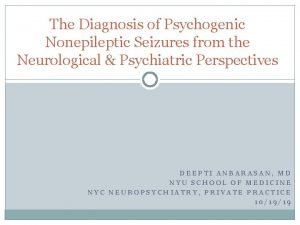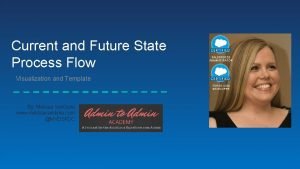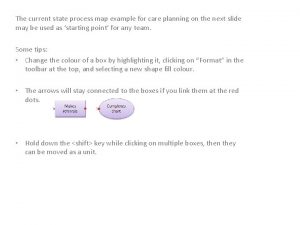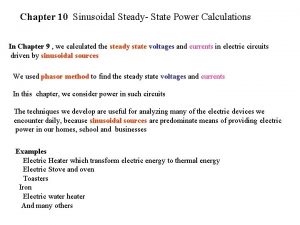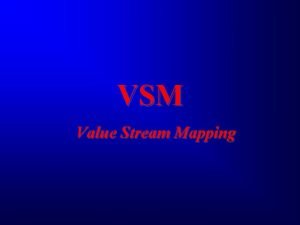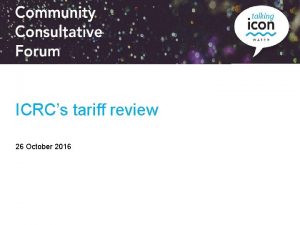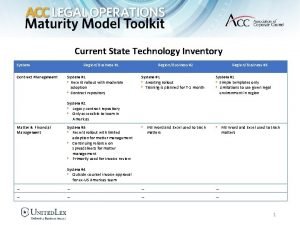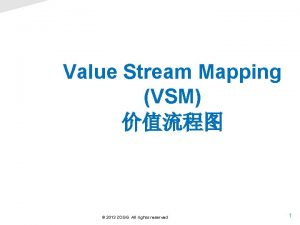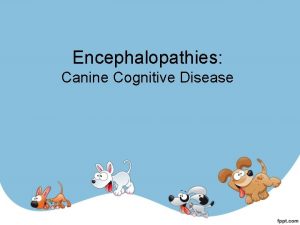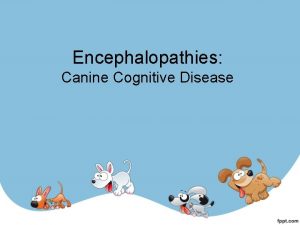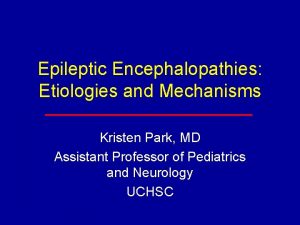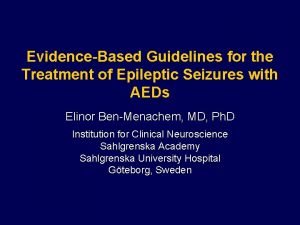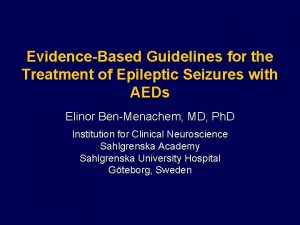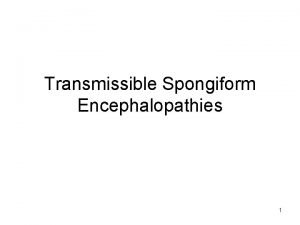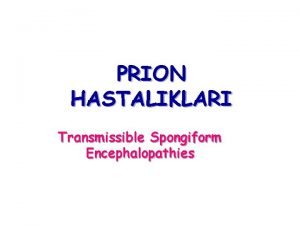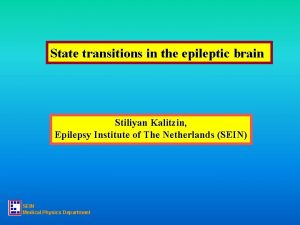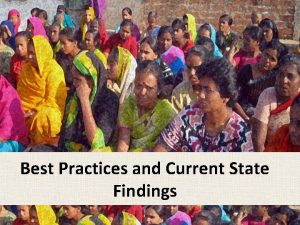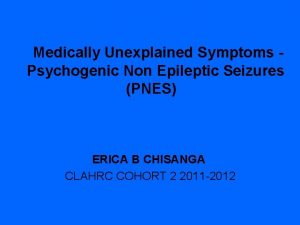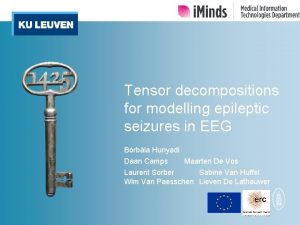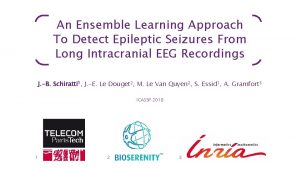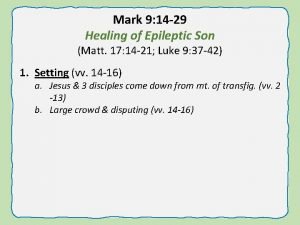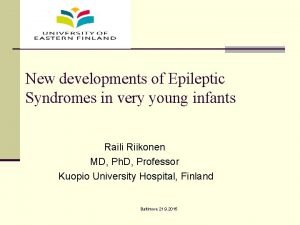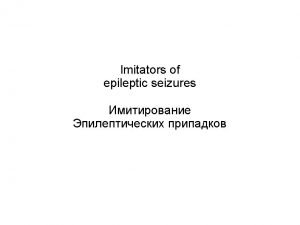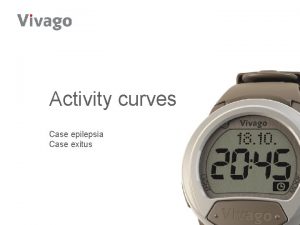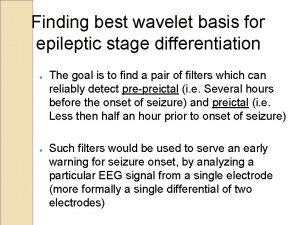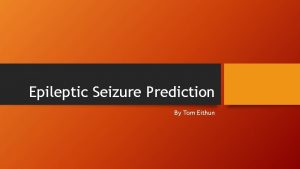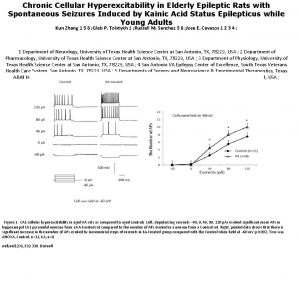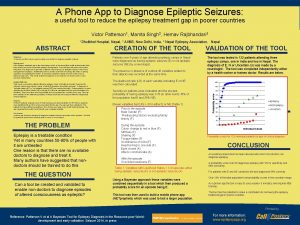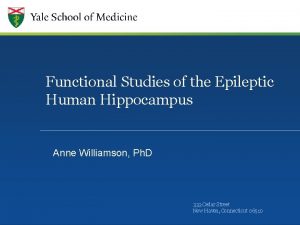Treatment of Epileptic Encephalopathies Current State of the


































- Slides: 34

Treatment of Epileptic Encephalopathies: Current State of the Art Shlomo Shinnar, MD, Ph. D Professor of Neurology and Pediatrics Hyman Climenko Professor of Neuroscience Research Director, Comprehensive Epilepsy Management Center Montefiore Medical Center Albert Einstein College of Medicine Bronx, New York

Shinnar Disclosures n n Funded by NIH/NINDS grants 2 R 37 NS 043209, 2 U 01 NS 045911, U 10 NS 077308 and 1 U 01 NS 088034 Consulting: Epalex, Neurelis, Upsher Smith, Xeris Scientific Advisory Boards: Acorda, Astra. Zenica, Questcor, Upsher-Smith DSMB: UCB Pharma

Treatment of Epileptic Encephalopahties- Overview Generally medically refractory from onset n Treatment often not with conventional AEDs n n n Hormonal therapy plays a prominent role Goal is not just to control seizures but to prevent or reverse neurological loss of function n One of few settings where treating the EEG may be important

Infantile Spasms: Definition of Responder n In the American Academy of Neurology (AAN) and Child Neurology Society (CNS) practice parameter, a responder is characterized by n n Complete cessation of spasms, as confirmed by video electroencephalogram (EEG) Abolition of hypsarrhythmia on prolonged EEG Mackay et al. Neurology 2004; 62: 1668 -1681.

Infantile Spasms: Definition of Responder The AAN/CNS practice parameter definition of response as an “all or none” phenomenon is very different from the usual definition of 50% reduction in seizures n It reflects our understanding of the pathophysiology of the disease n n Unless one abolishes the hypsarrhythmia, there is progression and cognitive decline Mackay et al. Neurology. 2004; 62: 1668 -1681

ACTH: High-dose ACTH vs Prednisone (1996) Regimen Etiology (n=29) Response Percentage of Patients (n) Symptomatic 76 (22) Cryptogenic 24 (7) ACTH responders (n=15) 87 (13) Prednisone responders (n=14) 29 (4) Cross-over responders Baram et al. Pediatrics. 1996; 97: 375 -379. Prednisone ACTH (n=9) ACTH Prednisone (n=2) 89 (8) 50 (1)

Oral Corticosteroids n n Likely have efficacy but data are unclear. In the RCTs high dose ACTH is superior UKISS did not utilize video EEG and used very low dose ACTH The recent study by Hussain et al did show improved response rate using the UKISS regimen confirmed by video. EEG. Even in that trial some of the failures responded to ACTH. Arya et al J Child Neurol 2012; 27: 1284 -1288 Mackay et al. Neurology. 2004; 62: 1668 -1681 Hussain et al Epilepsia 2014; 55: 103 -107 Lux et al Lancet 2004; 364(9447)1773 -1778

How Does ACTH Work? n. Release of natural corticosteroids from adrenals; low dose sufficient action on the CNS; high dose needed as poor penetration across Blood Brain Barrier Hippocampus CRH Amygdala Hypothalamus n. Direct CRH Pituitary CORTISOL ACTH Adrenal Brunson et al. Ann Neurol. 2001; 49: 304 -12 2 1

ACTH: Relapse Rates and Time to Treatment n Singer et al, 1980 n n 55 patients treated with ACTH (80 U QOD) Response rate ä n Relapse rates ä ä n 3. 7% for infants treated within 1 month of spasm onset 21. 4% for infants treated after 1 month of infantile spasms diagnosis Sher et al, 1993 n n n 26 patients treated with ACTH (40 -129 U/m 2/d) Response rate: 65% of patients (17 out of 26) Relapse rates ä n Treatment with ACTH within the first month of onset of spasms produced a higher incidence of spasm-free state and a shorter duration of spasms compared with a similar regimen of ACTH begun after seizures had persisted for more than a month 1 relapse of spasms during the initial withdrawal of medication; 1 infant experienced a “recurrence” of infantile spasms many months later Early treatment with high response rates and low relapse rates Singer et al. J Pediatr. 1980; 96: 485 -489 Sher and Sheikh. Pediatr Neurol. 1993; 9: 451 -456.

ACTH: Cognitive Outcomes n Favorable cognitive outcomes n In cryptogenic cases treated early, there is a high rate of long-term normal outcome Normal is defined as normal intelligence and no seizure disorder, on no medications ä This is really NORMAL ä Kivity et al. Epilepsia. 2004; 45: 255 -262 Lombroso. Epilepsia. 1983; 24: 135 -158 Riikonen. Brain Dev. 2001; 23: 683 -687 Cohen-Sadan et al Eur J Neurol 2009; 16: 482 -487.

Vigabatrin n AAN/CNS practice parameter n VGB is possibly effective for short-term treatment of infantile spasms ä n n Tuberous sclerosis Serious concerns about retinal toxicity Review of 14 studies n n 1 placebo-controlled randomized 2 randomized controlled 6 prospective open-label 5 retrospective case series Mackay et al. Neurology. 2004; 62: 1668 -1681.

Patients (%) Vigabatrin + Resolution of Spasms and Hypsarrhythmia VGB* (n=20) *Etiology Resolution of Spasms Placebo* (n=20) of infantile spasms in each group: 70% symptomatic, 30% cryptogenic/idiopathic. Appleton et al. Epilepsia. 1999; 40: 1627 -1633.

Vigabatrin n In other randomized controlled studies n Symptomatic responders: 21% to 44%1 -3 ä Tuberous sclerosis (5 prospective studies)1, 3, 4 -6 ä ä ä n Overall cessation of spasms: ~91% 100% response rate reported Cryptogenic responders: 27% to 57%1 -3 Relapse rate: 8% to 20%1 -3 1. Vigevano and Cilio. Epilepsia. 1997; 38: 1270 -1274. 2. Appleton et al. Epilepsia. 1999; 40: 1627 -1633. 3. Elterman et al. Neurology. 2001; 57: 1416 -1421. 4. Covanis et al. J Epilepsy. 1998; 11: 265 -269. 5. Vles et al. Neuropediatrics. 1993; 24: 230 -231. 6. Granstrom et al. Epilepsia. 1999; 40: 950 -957.

Hormonal Therapy vs Vigabatrin n UK Infantile Spasms study comparing vigabatrin with hormonal therapy with vigabatrin n n Minimum doses n n n Hormonal therapy 73% (40/55) Vigabatrin 54% (28/52) p=0. 04 Cognitive outcomes in cryptogenic cases at 12 -14 months n n n 1. Tetracosactide (ACTH analogue) 40 IU qod IM (n=25) Prednisone 40 mg per day (n=30) Vigabatrin 100 mg per day (n=52) Efficacy n n Primary outcome was clinical cessation of spasms Vineland scales Hormonal therapy mean =88 Vigabatrin therapy mean = 79 Lux et al Lancet 2004; 364(9447)1773 -1778. 2. Lux et al. Lancet Neurology 2005; 4: 712 -717. p=0. 025

Dietary Therapies: Ketogenic Diet n KD (n=13) vs ACTH (n=20) as initial therapy n Retrospective, nonrandomized n After 1 month of therapy n Spasm freedom ä KD, n 62% (8/13) vs ACTH, 90% (18/20; P=0. 06) Normal EEG ä ACTH, 53% (9/17) > KD, 9% (1/11; P=0. 02) n No difference in relapse n Adverse events (6 months) n KD, 31% (4/13) < ACTH, 80% (16/20; P=0. 006) Kossoff et al. Epilepsia. 2008; 49(9): 1504 -1509. 15

Summary of recommendations for the management of infantile seizures: Task Force Report for the ILAE Commission of Pediatrics n Infantile spasms – NOT Tuberous Sclerosis n n n ACTH – level B Alternative options (expert opinion – consider for infants with static severe neuro-insults and no regression) ä Oral steroids ä Vigabatrin ä Valproate Infantile spasms – Tuberous Sclerosis n Vigabatrin – level C Wilmshurst et al Epilepsia 2015 56: 1185 -1197

Surgical Treatment of Infantile Spasms Patients (%) Outcome 60 50 40 30 20 10 0 Class: 1 2 3 4 5 24 -60 Mont 12 -24 Months 6 -12 Months 0 -6 Months Seizure <1/ 1 -4/ 5 -30/ >30/ Free Month Shields. Int Rev Neurobiol. 2002; 49: 253. 17

Surgical Treatment of Infantile Spasms Surgical Procedure Tumor (n=2) TSC (n=2) Other (n=4) 4% 8% Lobar Resection 12% (n=6) Multilobar Resection (n=16) Shields. Int Rev Neurobiol. 2002; 49: 253. 4% 41% Hemispherectomy (n=21) 31% 18

Future Research n Further studies are required to determine the optimal treatment of children with infantile spasms n n Further studies of new agents and antiepileptic drugs are required to assess their efficacies Development of animal models can help identify novel targets for therapeutic development Long-term measures should include cognitive outcomes using standardized psychometric assessments Standardized dosage and duration of treatment are essential to allow comparison of short- and long-term outcomes Mackay et al. Neurology. 2004; 62: 1668 -1681.

International League Against Epilepsy (ILAE) Treatment Guidelines “There is an especially alarming lack of welldesigned, properly conducted RCTs for patients with generalized seizures/epilepsies and for children in general. ” Courtesy Dr Wheless.

Lennox-Gastaut Syndrome: Treatment 1. Medical n n Historical/Expert 1 st Choice: Valproate 1, 2, 4 USA FDA Approved: clobazam, clonazepam, felbamate, lamotrigine, rufinamide, topiramate 1 Montouris GD, Wheless JW, Glauser TA. Epilepsia, 2014; 55 (Suppl. 4): 10 -20. 2 Wheless JW et al. Pediatr Neurol, 1997; 17(3): 203 -211. 3 Wheless JW et al. Epilepsia, 2004; 45(Suppl. 5): 17 -22. 4 Wheless JW et al. J Child Neurol, 2009; 24(Suppl. 8): S 24 -S 32. 5 Wheless JW et al. J Child Neurol, 2005; 20 (Suppl. 1): S 1 -S 60. Courtesy Dr Wheless

Lennox Gastaut n Hormonal/Immune Therapy n n n Steroids ACTH IVIG No RCTs. Small cases series reporting some benefit in each case. Vigevano et al Epilepsia 2013; 54 (Suppl 8): 45 -50 Mikati et al Epilepsy Behav 2010; 17: 90 -94

Lennox-Gastaut Syndrome: Treatment 2. Dietary 2, 3: Ketogenic diet, Atkins diet, Low glycemic index diet 3. Surgical 2, 3: Vagus nerve stimulation, Complete corpus callosotomy Lesionectomy/lobectomy 1 Montouris GD, Wheless JW, Glauser TA. Epilepsia, 2014; 55 (Suppl. 4): 10 -20. 2 Wheless JW et al. Pediatr Neurol, 1997; 17(3): 203 -211. 3 Wheless JW et al. Epilepsia, 2004; 45(Suppl. 5): 17 -22. 4 Wheless JW et al. J Child Neurol, 2009; 24(Suppl. 8): S 24 -S 32. 5 Wheless JW et al. J Child Neurol, 2005; 20 (Suppl. 1): S 1 -S 60. Courtesy Dr Wheless

Lennox – Gastaut Syndrome Treatment Sequence 1 st AED Monotherapy 2 nd AED Monotherapy OR Polytherapy Trials Re-evaluate Consider Other Treatments Epilepsy Surgery Vagus Nerve Stimulation Medications Ketogenic Diet Courtesy Dr Wheless

Lennox Gastaut We do not have good treatments for full seizure freedom except in rare lesional cases n Our treatments are not very good at preventing slow cognitive decline n Cognitive and behavioral outcomes have not been outcome variables in the drug trials n No good comparative effectiveness trials among the available therapies. n

Treatment of ESES n Pooled analysis of 575 patients (950 treatments) n n Cognitive domain EEG improvement (>25% reduction in spike wave index) Van den Munckhof et al - epilepsy stockholm 2014

Treatment of ESES Improvement Treatment N Cognitive EEG AED 310 32% 33% Benzodiazepines 107 45% 46% Steroids 100 70% 68% Surgery 30 83% 74% Other 38 71% 26% Total 585 44% 43% Van den Munckhof et al - epilepsy stockholm 2014

RESCUE ESES - Randomized European trial of steroids versus Clobazam Usage for Encephalopathy with ESES n 130 children age 2 -12 years with ESES syndrome - within 6 months of diagnosis n n n Outcomes (after 6 and 18 months) n n n Steroids – methylprednisolone pulse-therapy IV or oral prednisolone Clobazam Primary – cognition Secondary – EEG (SWI during non-REM sleep), seizures, safety and tolerability Currently recruiting Van den Munckhof et al - epilepsy stockholm 2014

Autoimmune Encephalopathies n In common with the epileptic encephalopathies which may well overlap n n n You are treating more than just the seizures. EEG is often encephalopathic There is an associated decline in neurological function

Autoimmune Encephalopathies No evidence based consensus guidelines n Seizures treated with appropriate AEDs n Mainstay of treatment are immune therapies n

Autoimmune Encephalopathies n First Line Treatment n n Corticosteroids Intravenous Gammaglobulins Plasmaphoresis Second Line Treatments n n Cyclophosphamide Rituximab Lim et al Pediatr Clin North Am 2015; 62: 667 -685

Autoimmune Encephalopathies We are in need of RCTs to determine optimal therapy n We are hindered by n n Relative rarity of cases Not clear that class is homogenous Diagnosis often made late in the course

Summary n While epileptic encephalopathies are a small proportion of all epilepsy, they account for a disproportionate amount of intractable epilepsy with adverse effects on cognition, QOL, higher rate of SUDEP and increased economic burden on families.

Summary We need better evidence based guidelines for the treatment of these disorders. n Novel therapies are very much needed n Treatments are needed not just for the seizures but to improve overall neurological outcomes, especially cognition and behavior n You will be hearing about some potential novel treatments in the remainder of this session. n
 Epileptic meaning
Epileptic meaning Psychogenic seizures
Psychogenic seizures Current state vs future state diagram
Current state vs future state diagram Line currents
Line currents Difference between phase voltage and line voltage
Difference between phase voltage and line voltage Energy band diagram of pnp transistor
Energy band diagram of pnp transistor Lesson 4 three-phase motors
Lesson 4 three-phase motors Drift current and diffusion current in semiconductor
Drift current and diffusion current in semiconductor Ceramic composition resistors
Ceramic composition resistors The jfet always operates with
The jfet always operates with Wye delta diagram
Wye delta diagram Infineon
Infineon Drift current and diffusion current in semiconductor
Drift current and diffusion current in semiconductor A splice in a welding cable should never be any closer than
A splice in a welding cable should never be any closer than Hazard based safety engineering
Hazard based safety engineering Non planar circuit
Non planar circuit Current state map
Current state map Sinusoidal steady state power calculations
Sinusoidal steady state power calculations Value stream map esempio
Value stream map esempio Current state icon
Current state icon Overview of the current state of technology
Overview of the current state of technology Vsm 2013
Vsm 2013 Hình ảnh bộ gõ cơ thể búng tay
Hình ảnh bộ gõ cơ thể búng tay Lp html
Lp html Bổ thể
Bổ thể Tỉ lệ cơ thể trẻ em
Tỉ lệ cơ thể trẻ em Chó sói
Chó sói Glasgow thang điểm
Glasgow thang điểm Alleluia hat len nguoi oi
Alleluia hat len nguoi oi Kể tên các môn thể thao
Kể tên các môn thể thao Thế nào là hệ số cao nhất
Thế nào là hệ số cao nhất Các châu lục và đại dương trên thế giới
Các châu lục và đại dương trên thế giới Cong thức tính động năng
Cong thức tính động năng Trời xanh đây là của chúng ta thể thơ
Trời xanh đây là của chúng ta thể thơ Mật thư tọa độ 5x5
Mật thư tọa độ 5x5

